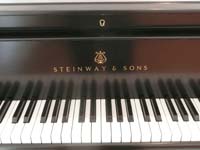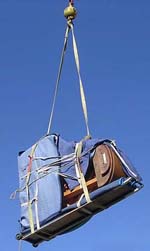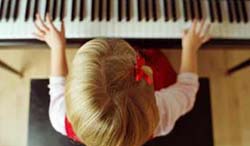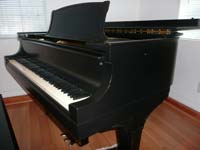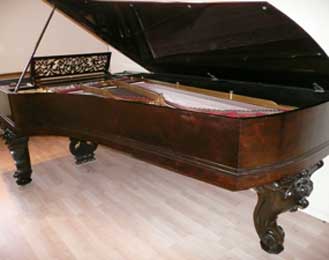In the first installment of this series, we talked about the evolution of the piano in terms of traditional pianos and the new design elements being implemented. The use of synthetic materials in traditional pianos is an incredibly interesting development in piano design and production. I received a number of comments from all of you and I really appreciate the conversation and insight you all provided.
In this next installment, I would like to discuss the advancement of pianos when it comes to digital and hybrid pianos. They have come a long way, so long that they are actually becoming a preferred format for certain musicians and venues.
Many years ago the first attempts at making electric pianos emerged. In truth, they sounded nothing like actual pianos. The Wurlitzer and the Fender Rhodes pianos had traditional piano keyboards but they produced bell-like sounds. It wasn’t until the late 1970’s and early 1980’s with the invention of digital sampling that digital pianos could actually sound like a real piano! They achieved this by having little recordings for each note and then looping them – the technology wasn’t available to record the entire length of each note so only a small sample of the attack portion of the note was used. The decay of the notes was achieved by looping a portion of the sound and fading it out. I actually owned a Kurzweil K250 – an 88 note digital wooden key piano, one of the first instruments capable of replicating the sound and feel of a piano. I enjoyed producing many soundtracks in my studio since the Kurzweil offered hundreds of strikingly realistic instrument replications.
Since that time, digital sampling has evolved tremendously. Now digital pianos most often have several recordings of each note at different velocity levels. The realism of these instruments is simply astounding. There is actually a newer technology called physical modeling which takes into account the attack of the keys and the hammers hitting the string and many other aspects of the sound we never thought possible when digital pianos were first invented. This technology makes it possible to replicate pianos that couldn’t exist in the real world – twelve and twenty-foot pianos, aluminum strings – the possibilities are endless.
Some of the best digital pianos today are software based, which is why a lot of professionals utilize something called keyboard controllers. These don’t produce sounds but they actually transmit key information via MIDI (Musical Instrument Digital Interface) to a laptop, computer, or sound module which allows the player to use the latest in technology without having to buy new keyboards every year.
Digital pianos generally fall into two categories: portable and home units. Portable digital pianos are generally used by professionals. They usually have no speakers or very small speakers on board. They are hooked into sound systems for performance and recording. These are like portable pianos except they produce sound digitally and have a much simpler type of action mechanism. The other type of digital piano can actually look like a real piano but they have no strings or soundboard. They also produce the sound digitally but have substantial sound systems built into sometimes extravagant furniture.
In my opinion, some of the inexpensive digital pianos are just as good as units costing much more. When you spend more you are mostly getting better furniture and more substantial sound systems. Some of these high-end digital pianos from Korg, Yamaha, Kurzweil, and others are so advanced they offer the players even more options than ever before. You can plug in microphones to harmonize your voice with the piano; you can record yourself digitally creating full orchestrations! There are music software programs for learning music theory and more.
But are digital pianos really a substitute for traditional pianos? In a pinch, yes. But what’s more impressive about these instruments is the things you can’t do with a traditional piano. As far as recording music, the software available on these pianos is incredibly powerful – you can record multiple lines of music, you can bring up your notes and edit them; the options are endless. It’s like having a word processor for music at your fingertips!
But when it comes to hybrid pianos, things get a little more interesting. Roland and Yamaha have pianos now that are considered hybrids – they are trying to bridge the line between digital and acoustic pianos and they are getting closer.
Some of these hybrid pianos like the Yamaha AvantGrand actually have full piano actions in them and function as normal, but the sound is created digitally.
These pianos can be incredibly useful in certain situations. If you ever had to practice on a practice room piano in a school, you know how hideously out of tune these pianos almost always are. With people playing them constantly they will hardly ever be in tune or voiced to a decent level of performance. Traditional pianos just aren’t capable of withstanding that kind of use. With a hybrid piano – where the action is the same as a real piano but the sound is digital – this can provide a better alternative to an acoustic piano. There are plenty of situations – like hotels or restaurants where hybrid pianos offer an ideal solution.
The question is whether we will ever get to a point where hybrid pianos are actually more common than traditional acoustic pianos? I believe that there is nothing better than an acoustic piano, however, in certain situations, I would much prefer to play on a high-quality hybrid piano than a beaten up acoustic piano.
As always, I’m interested in your opinions and thoughts on this matter. Robert Estrin: Robert@LivingPianos.com (949) 244-3729





















